| dc.contributor.advisor | Mukhatov, Kirill | |
| dc.contributor.advisor | Tolstorebrov, Ignat | |
| dc.contributor.advisor | Olaussen, Tina | |
| dc.contributor.author | Hansen, Marcus Hoff | |
| dc.contributor.author | Michelsen, Emilie | |
| dc.date.accessioned | 2021-09-25T16:14:14Z | |
| dc.date.available | 2021-09-25T16:14:14Z | |
| dc.date.issued | 2021 | |
| dc.identifier | no.ntnu:inspera:81708024:81953169 | |
| dc.identifier.uri | https://hdl.handle.net/11250/2782650 | |
| dc.description.abstract | Hensikten med oppgaven var å studere prosessforhold ved enzymatisk hydrolyse av restråstoff, og finne de mest optimale forholdene for størst mulig proteinutbytte. Motivasjonen for oppgaven var engasjement og interesse for utvikling av teknologi som kan bidra til verdiøkning og en mer bærekraftig matindustri.
Oppgaven tok for seg enzymatisk hydrolyse av restråstoff fra krabbeforedling for dannelse av proteinholdig hydrolysat. Det ble gjennomført i alt 14 hydrolyser, der type råstoff, enzym, enzymkonsentrasjon og hydrolyseringstid ble valgt som varierende faktorer. Restråstoffet som ble brukt var fra kokt og rå krabbe. Enzymene papain og bromelain ble sammenlignet ved konsentrasjonene 0%, 0,1% og 1%, og hydrolysering på 1 time og 6 timer ble vurdert. Prøvene bestod av råstoff og vann i forholdet 1:2, og hydrolyseringstemperatur ble bestemt til å være 50°C.
Etter hydrolysering ble alle prøvene analysert for tørrstoffinnhold, og deretter tørket ved spray- eller frysetørking. Videre analyser for å finne innhold av nitrogen, frie aminogrupper og protein ga grunnlag for beregning av hydrolysegrad samt vurdering av de ulike forholdene. Noen utvalgte prøver ble også analysert for saltinnhold. Brixmåling ble brukt under 6 timers hydrolyse som indikasjon på tørrstoffinnhold, for å kunne følge utviklingen i hydrolyseprosessen over tid. Senere ble et temperaturforsøk utført på råstoffet ved 30°C, 40°C og 50°C for å undersøke eventuell sammenheng med denaturering av proteiner. Fargeanalyse ble til slutt utført på alle prøvene for å vurdere kvalitet.
Vurdering av prosessforholdene ble gjort ved å se på resultater fra analysene av prøvene, og sett i sammenheng med restråstoffenes sammensetning. Hydrolysatene hadde et proteininnhold på 50,07-62,07%. Ut ifra forsøkene som ble gjennomført, ble det konkludert med at de mest optimale prosessforholdene for størst mulig proteinutbytte var bruk av restråstoff fra rå krabber med tilsats av 1% papain. Ut ifra fargeanalysene ble det bestemt at hydrolysatene fra kokt restråstoff hadde best kvalitet. | |
| dc.description.abstract | The purpose of this thesis was to study the processing conditions for enzymatic hydrolysis of rest raw material from brown crab, and to find the most optimal conditions for the recovery of protein. The motivation for this task was the engagement and interest for development of technology that can contribute to value increase and a more sustainable food industry.
This thesis dealt with enzymatic hydrolysis of rest raw material form crab processing to create a protein rich hydrolysate. A total of 14 samples was hydrolysed, where type of rest raw material, enzyme, enzyme concentration and hydrolysis reaction time were chosen as variable factors. The rest raw materials used came from boiled and raw crab. The enzymes papain and bromelain were compared in the concentrations 0% 0,1% and 1% and hydrolysis reaction time of 1 and 6 hours was evaluated. The samples consisted of rest raw material and water in the ratio of 1:2, and hydrolysis reaction temperature was decided to be 50ºC.
After hydrolysation all samples was measured for dry matter content, and there after dried by spray and freeze drying. Further analysis to find the content of nitrogen, free amino groups and protein gave the basis for calculation of degree of hydrolysis and evaluation of the different conditions. Some selected samples were also analysed for salt content. The measurement of Brix value during the six-hour hydrolysis experiment gave an indication of dry matter content, which was used to follow the increase of dry matter content over time. A temperature experiment was performed on the rest raw material to investigate any effects of protein denaturation at different temperatures.
Evaluation of processing conditions were done by evaluating the results of the samples and compered with the composition of the rest raw material. The hydrolysates had a protein content of 50,07-62,07%. Based on the experiments that were done, it was concluded that the most optimal processing conditions for the recovery of protein was by the use of rest raw material from raw crab, with the addition of 1% papain. From the color analysis it was decided that the hydrolysates from boiled crab rest raw material had the best quality. | |
| dc.language | nob | |
| dc.publisher | NTNU | |
| dc.title | Verdiøkning av restråstoff fra krabbeforedling | |
| dc.type | Bachelor thesis | |
